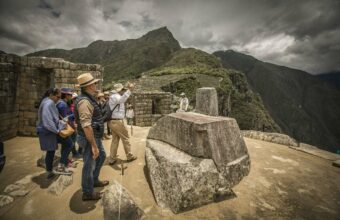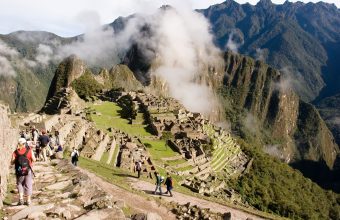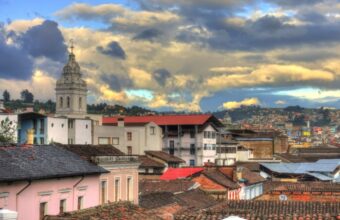What To Do In The Galapagos Islands
Activities island-by-island
The Galapagos archipelago comprises six major islands, 14 minor islands, and over 40 islets. Having emerged from volcanic activity over a huge span of time, each island is unique in its age and natural history. Each one has something a little different to offer visitors. Here are the most accessible islands to visit and a few of their highlights.
What to do in the Galapagos
Santa Cruz
Puerta Ayora, the main town on Santa Cruz island, is the tourist center of the islands -- tour agencies, airline offices, restaurants, banks and shops line the streets. It’s a stop on most tour itineraries and the place to finalize travel plans, find gifts for friends and family, and sample local cuisine.
- Hike to Tortuga Bay on a path that ends at beaches perfect for snorkelling.
- The lava tubes in the highlands are some of the largest in the islands.
- The wharf off of the main drag pits the local fish merchants against the sea lions that vie for the daily catch.
- The Charles Darwin Foundation is the original rallying point for scientific and conservation efforts in the islands. Don’t miss the Giant Tortoise Reserve!
San Cristobal
San Cristobal is the provincial capital of the Galapagos. One of the oldest islands, it was Darwin’s first stop on his historic journey. It’s the home to government and educational institutions.
- Puerto Baquerizo Moreno acts as the second tourist center for the islands. Offices of tour agencies, foundations and branches of banks are open during the week.
- Sapho Bay and the waters around the adjacent Kicker Rock are popular places for snorkeling to see rays, Galapagos sharks and the occasional hammerhead.
Isabela
Originally named Albemarle Island by pirate Ambrose Cowley, Isabela is one of the youngest and largest of the Galapagos archipelago. It was formed by six volcanoes: Sierra Negra , Wolf, Alcedo, Cerro Azul, Darwin and Ecuador. All are active except Ecuador; Sierra Negra erupted most recently in 2018.
- Take a horseback ride to the top of the Sierra Negra Volcano.
- Spot Humpback Whales off the western coast of the island from June to September.
- See the Galapagos penguins near Tagus Cove. The cove was a favorite of pirates and whalers; names of ships dating back to 1836 are carved into the nearby cliff sides.
Floreana
After being marooned on Floreana in 1805, Irishman Patrick Watkins became the first known Galapagos resident. Post Office Bay is also here, an informal mail system started in the 1700s by whalers. Mail was left for ships returning home in a barrel by those headed out to sea. The tradition lives on today.
- Leave postcards at Post Office Bay for others to pick up and deliver once home.
- Cormorant Point has two contrasting beaches; a green sand beach caused by olivine crystals and Flour Beach, made from crushed white coral.
- See pink flamingos at the nearby Flamingo Lagoon.
- Watch for Green sea turtles nesting on the sands of Flour Beach.
- Take a short hike and a small decent by ladder, leading to a lava tube that extends a few hundred yards underneath the surface.
- Take a panga ride to Gardner Inlet for a view of the large caves and rock formations of the island.
Española Island
On this island, you’ll be greeted by colonies of sea lions and Española lava lizards lounging freely. It’s also known for its nesting sites of Blue-footed and Nazca boobies.
- Hike the Punta Suarez trail to the edge of a cliff overlooking a natural lava blowhole.
- Waved Albatross breeding colony. The world’s population of the species migrates here during April and December. Elaborate mating rituals lead to partnerships for life.
- The white sand beach at Gardner Bay is one of the longest in the islands.
- Sea turtles bury their eggs on the beach during mating season between January and March.
Bartolomé
One of the sites used in the movie “Master and Commander,” Bartolomé is famous for Pinnacle Rock, a volcanic outcrop formed after lava erupted from an underwater volcano. The iconic formation was used for target practice by US airmen during WWII, adding to its unique shape.
The colorful scenery of the beaches on either side of Pinnacle Rock is contrasted by the barren landscape of Bartolomé’s interior. It’s often compared to the moon or Mars due to the red lava rocks away from the shore.
- Climb to the top of the island’s summit, ascending a wooden staircase through the stripped-down landscape. A panoramic view awaits.
- See Galapagos penguins, sea turtles, parrotfish, and small sharks in the shallow waters between the landing point and Pinnacle Rock.
North Seymour
North Seymour is home to one of the island’s first conservation projects. In the 1930s, the crew of Captain Alan Hancock’s ship transferred 72 land iguanas from the nearby Baltra Island to North Seymour in the hopes that the reptiles would fare better without the feral goats competing for food. At last count in 2014, there were 2500 land iguanas on the island.
- Visit a flamingo lagoon on the isolated Bachas Beach.
- Great Frigate birds have the largest nesting colony to be found on the islands.
Where to go snorkelling in the Galapagos
Snorkelling in the Galapagos Islands allows for thrilling underwater adventures where a whole new world opens up. The Galapagos Marine Reserve is home to sea lions, green sea turtles, billowing clouds of tropical fish, penguins and sharks.
Bartolomé Island
Bartolomé Island’s iconic Pinnacle Rock is the place to find penguins. These quick-moving swimmers are frequent companions in the bay especially when the Humboldt Current moves in from Antarctica and cools off the water, attracting them in from the western islands.
North Seymour Island and Mosquera Islet
North Seymour Island and the neighbouring Mosquera Islet are home to a large population of sea lions. Snorkelling here puts you up close and personal with these curious creatures and their young pups.
Floreana Island
Off the shores of Floreana Island is the Devil’s Crown — a partially submerged, extinct volcano where wildlife thrives. Sea turtles, sea lions and even sharks are commonly seen in and around the crater, while seabirds crowd the outlying cliffs.
Isabela Island
Isabela Island’s Los Túneles is a series of pools sheltered from the sea’s currents with interlacing volcanic bridges spanning the depths. The crystal waters are home to decades-old sea turtles, large sea horses, white-tipped reef sharks and thriving schools of tropical fish.
Safe snorkelling
The biggest dangers associated with snorkelling in the Galapagos Islands are strong currents and accidentally stepping somewhere you shouldn’t. White-tipped reef sharks rest during the day in shallow waters and can be startled. Currents at outlying sites throughout archipelago can be strong even for experienced swimmers.
Where to dive on the Galapagos
Scuba diving in the archipelago puts you face-to-face with hundreds of hammerhead sharks, exploring underwater cliffs and caves, or sharing the water with dolphins and whales. Each site attracts a different crowd, so choose carefully.
Dive shops in Puerto Ayora rent equipment, as do live aboard boats, but most cruises recommend that you bring your own gear to ensure safety and comfort.
Gordon Rocks
Off the coast of Santa Cruz Island, Gordon Rocks is a submerged volcano where the depths reveal hammerhead sharks, rays, and sea turtles. Currents can be strong and swells in the shallows mean that divers need to stay below 40 ft.
Kicker Rock
Kicker Rock near San Cristobal Island is one of the best-known sites in the islands to see hammerhead sharks. Hundreds gather in the depths here, while the lion-shaped shadow of Kicker Rock towers above you. Kicker Rock is two hours from San Cristobal and you must be accompanied by a guide.
Wolf and Darwin Islands
Only accessible on live aboard cruises, Wolf and Darwin Islands have multiple dive sites where whale sharks, humpback whales and dolphins are found between June and November. Currents can be strong, but the giants of the sea are only found around these two islands.
Where to hike on the Galapagos
Hiking is an everyday part of exploring the islands. Day trips and cruises combine time spent discovering uninhabited islands and snorkelling by sea.
Treks find you on the top of high vistas overlooking scenic bays, walking on trails next to colonies of blue-footed boobies and sea lions, and even hiking up active volcanoes.
Sierra Negra volcano — Isabela Island
Sierra Negra volcano is one of six that formed Isabela Island. It has the second largest caldera (volcanic crater formed when a volcano falls in on itself) in the world and last erupted in 2018. This is a popular hike that takes you through forests and high above the tree line where views stretch across the crater to the neighbouring islands.
Bartolomé Island
Landing at the beach at Bartolomé Island, the path leads up an ascending set of stairs that take you over the volcanic landscape and to a lookout that spans the bay below. Seen in countless movies and postcard perfect pictures, it’s one of the best views in the archipelago.
Cerro Tijeretas — San Cristobal Island
Cerro Tijeretas is reached by a short hike past the Interpretation Centre on San Cristobal. The vista offers an amazing view over the bay below and there are trails down to the water and around the area.
The Punta Suarez trail — Española Island
The Punta Suarez loop trail is a short one-mile trail that puts you in the middle of exotic landscapes and beaches. Sea lions, blue-footed boobies and waved albatrosses are found along the trail and towering cliffs frame the landscape and coast.
Where to sea kayak on the Galapagos
Kayaking in the Galapagos Marine Reserve puts you on the water exploring the beaches, coves and islets of the islands close up. Paddling along the coast introduces you to the region’s wildlife. Sea turtles swim alongside kayaks, sea lions follow in your wake and marine iguanas dive into the water to join the fun.
Tortuga Bay
Tortuga Bay on Santa Cruz Island is considered one of the best beaches in the world. While the first section has strong currents, the more sheltered part of the beach has opportunities to kayak against a backdrop of mangroves. This is a great route for those looking for fun away from the fray and wildlife that shies away from the beaten path.
El Garrapatero
Another fun spot on Santa Cruz is El Garrapatero beach, a short taxi ride from Puerto Ayora. After a short hike, the secluded beach opens up and kayaks are available to check out the surrounding waters. There is also a tide pool to snorkel or swim and a lagoon behind the sand where flamingos and finches are often seen.
Tagus Cove
Tagus Cove on Isabela Island was a hideout for whalers and pirates who used the archipelago as a refuge from the Spanish fleet. Kayak trips go up the coast from Puerto Villamil, stopping in the bay to explore and then hiking up to a lookout and Darwin’s Lake in the nearby highlands.
Where to surf in the Galapagos
While there are a collection of surfing spots in the Galapagos Islands, the place to go is San Cristobal. The beaches, their breaks, and the animals found here draw surfers from around the world.
Punta Carola beach
Punta Carola is the number one beach in the Galapagos for world-class surfing. During high tide, waves reach ten feet, but at low tide the surf eases up, making it a great place for beginners to hone their skills.
The beach has two breaks — the left reef break is good for beginners and the right break near the point is better for more experienced surfers.
Tongo Reef
Reached after a 15-minute walk south from town through a military zone, Tongo Reef is the surf spot for those who want an alternative to the ten-foot waves of other beaches but still want a challenge.
Waves here reach six feet at high tide -— providing thrills for all levels of surfers. Three take-off zones access the break. Bajito and Medio are the places for beginners and intermediate riders, while further out, Pico has bigger waves for expert surfers to push themselves to the limit.
El Cañón
A sought after surf spot for intermediate and advanced riders, El Cañón has a southern swell with six foot waves.
El Cañon is 20-minute walk from Helena's Garden, two blocks before Playa Man. The trail goes through a military base and a passport is required to enter. The biggest waves arrive between November and May.
La Loberia beach
La Loberia beach is within walking distance from town and is a good spot to surf, snorkel, swim and frolic with the friendly sea lion population.
It is a popular place for experienced surfers; the surf can get big at high tide. Waves move at a medium speed — but when the wind kicks up the water can get too rough to navigate.
Where to mountain bike on the Galapagos
Mountain biking in the Galapagos gives you a break from organised tours and set plans on cruise ships. Trails and routes take you into the highlands of the inhabited islands and let you stretch your legs while enjoying the lush scenery of the archipelago.
Santa Cruz Highlands
The highlands of Santa Cruz are a popular day trip when visiting the island. Trips combine visiting coffee farms and tortoise reserves with riding by bike to beaches on the coast.
La Soledad to Puerto Baquerizo Moreno, San Cristobal
La Soledad is a small lookout in the highlands of San Cristobal with a stunning view of the coast and Kicker Rock. The route takes you past El Progesso, one of the original settlements in the islands. There is a small restaurant at La Ceiba treehouse on the edge of town and a few shops where you can buy water and supplies.
The Wall of Tears -— Isabela Island
The route to the Wall of Tears takes you along the coast and up into the hills of the island. The wall itself is a stark reminder of the Islands’ past — where prisoners from the mainland toiled to build the wall in a futile effort to appease their jailers. The road along the shoreline is now closed to all but bikers and hikers.
Responsible biking
The Galapagos Islands’ lack of traffic makes it a safe place for cyclists. The biggest danger comes from cyclists’ impact on local wildlife. Make sure you stay to roads and permitted paths — never venture off track.
Best beaches on the Galapagos
The beaches of the Galapagos are exotic retreats where exploring brings you to secluded bays where sea lions and marine iguanas rest, flamingos feed in lagoons, and cool waters beckon to those who want to swim, surf, and snorkel.
Puerto Villamil beach
The beach in front of the sleepy town of Puerto Villamil on Isabela island overlooks the island’s bay. You can see penguins on outcrops and the water is inviting to those who want a dip after a big day of exploring. Small beachside bars and shaded hammocks make it a great spot to relax and unwind far away from the crowds.
Red beach — Rabida Island
The red sand of the beach on Rabida Island comes from the high iron content in the volcanic rock of the island. Sea lions greet those visiting from cruises on this strange landscape, framed by green cactus and palo santo trees.
Bachas beach, Santa Cruz Island
Bachas beach on Santa Cruz Island is often a stop on day trips to neighbouring uninhabited islands. Its protected bay is a great place to swim, and the nearby lagoons are home to flamingos feeding in the shallow water. The beach is named after two barges that were abandoned by the army after WWII.
Post Office Bay — Floreana Island
The beach at Post Office Bay is one of the few places that is just as interesting for its human history. Whalers who first visited the island set up a barrel for mail. Those returning from their time at sea would take mail home for those heading out on their long voyage. Today, visitors from cruise ships leave a postcard and take another home to deliver.
Stay safe
The wildlife of the Galapagos Islands beaches, though used to human presence, present the most danger in the islands. Male sea lions aggressively protect their harems and young, and sea life such as white-tipped reef sharks can be hard to spot in shallow reefs and can react when disturbed.











